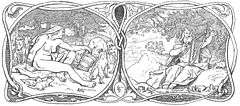Eggþér
Eggþér (also Eggthér, or Egdir) is a jötunn in Norse mythology. He is the herder of the giantess who lives in Járnviðr (Ironwood) and raises monstrous wolves.[1][2][3] Eggþér is described as sitting on a mound and joyfully striking his harp while the red rooster Fjalar begins to crow, heralding the onset of Ragnarök.[2]

Name
The Old Norse name Eggþér ('edge-servant') is a compound formed with egg ('edge') attached to þér ('servant').[4][2] It could have denoted a 'bearer of a sword', 'one who is servant of the sword'; perhaps, 'one who provides victims for battle'.[5] Eggþér is cognate with the Old English personal name Ecgþéow, the father of Beowulf in Old English poetry,[5][3] and with the Old High German Eggideo (or Eckideo).[4] They may stem from a common Proto-Germanic form reconstructed as *Agjō-þe(g)wa.[4]
According to Salus and Taylor, the Old Norse Eggthér ('Edge-Servant') is a descriptive agnomen derived from his function as the arouser of the jötnar and wolves to battle during Ragnarök. They argue that there is a "remote similarity" with Ecgþéow, since the latter was also known for the feuds he have brought about by his fighting. Both names could embody, in their separate traditions, the role of arousers of great battles and feuds.[6] Orchard and Lindow contend however that a mythological parallel between the two figures is most likely a "red herring".[2][3]
Attestation
Eggþér is mentioned in the poem Völuspá (Prophecy of the Völva) as the herder of the jötunn living in Járnviðr (Ironwood) and raising "the kinfolk of Fenrir" (wolves).[2] While the red rooster Fjalarr is heralding the onset of Ragnarök, Eggþér is portrayed as joyfully striking his harp.[5]
|
Theories
Scholar Andy Orchard notes that the scene of Ragnarök has a "curious echo" in the Icelandic Njáls saga, where the hero Gunnar is portrayed as singing joyfully on top of his own burial mound.[2]
The identity of the giantess mentioned in the poem is unclear. According to scholars, she is probably the one described in stanza 40 of the same poem, a figure possibly identified with the jötunn Angrboða. She is said to dwell in the forest of Járnviðr (Ironwood), where she raises the offspring of the wolf Fenrir.[1][3] Salus and Taylor contend that the herdsman Eggþér is not a shepherd, but rather a wolf-herder. In this view, Eggþér is portrayed as 'joyful' or 'cheerful' in Völuspá because the "rearing of the wolves will bring about the downfall of the gods", and he is striking his harp to "arouse his charge to ferocious deeds".[6]
References
- Salus & Taylor 1969, p. 79.
- Orchard 1997, p. 35.
- Lindow 2002, p. 102.
- de Vries 1962, pp. 94–95, 609.
- Salus & Taylor 1969, p. 78.
- Salus & Taylor 1969, p. 80.
Bibliography
- de Vries, Jan (1962). Altnordisches Etymologisches Worterbuch (1977 ed.). Brill. ISBN 978-90-04-05436-3.
- Lindow, John (2002). Norse Mythology: A Guide to Gods, Heroes, Rituals, and Beliefs. Oxford University Press. ISBN 978-0-19-983969-8.
- Orchard, Andy (1997). Dictionary of Norse Myth and Legend. Cassell. ISBN 978-0-304-34520-5.CS1 maint: ref=harv (link)
- Salus, Peter H.; Taylor, Paul B. (1969). "Eikinskjaldi, Fjalarr, And Eggþér: Notes on Dwarves and Giants in the Völuspá". Neophilologus. 53 (1): 76–81. doi:10.1007/BF01511692. ISSN 1572-8668.CS1 maint: ref=harv (link)